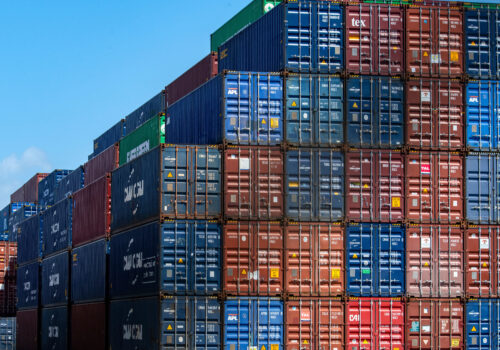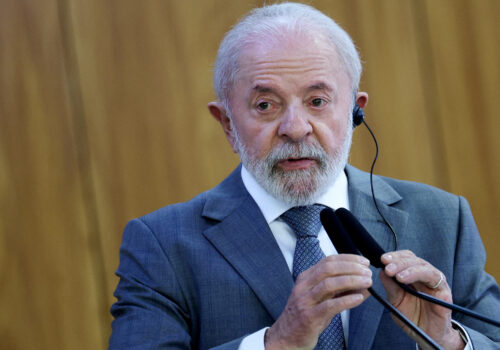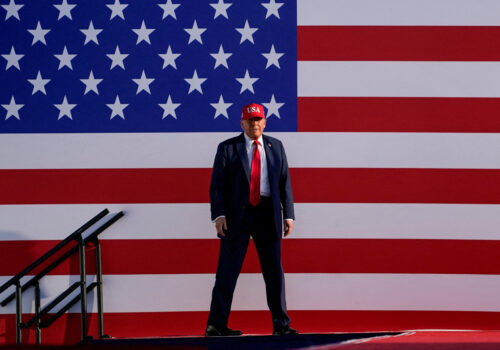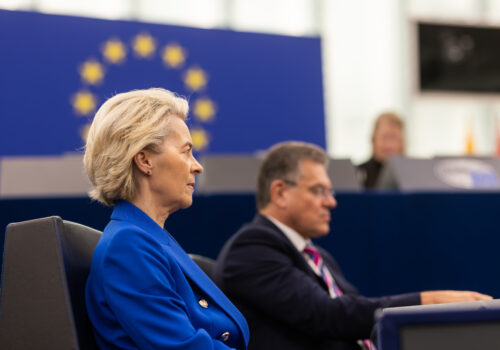Beware the ‘dangerous disconnect’ between Trump and the markets on tariffs
Wall Street keeps staking multibillion-dollar bets that US President Donald Trump doesn’t mean what he threatens when it comes to tariffs. That’s risky business, for the simple reason that most investors don’t seem to understand Trump’s thinking.
One who does seem to appreciate the US president’s seriousness is Treasury Secretary Scott Bessent, who said in an interview on Tuesday with Bloomberg that an “obsessive focus on the market isn’t right.” Trump, he explained, “views this as a generational opportunity to reset trade in a fair and sound manner for the American people.”
Josh Lipsky, the Atlantic Council chair for international economics, rightly calls this gap between the administration and investors “a dangerous disconnect.” It’s prompting Wall Street to keep buying stocks and Trump to keep threatening more tariffs—neither believing there’s ultimately any price to pay.
Something’s got to give—and possibly soon. If the US president follows through on the August 1 deadline of his latest round of tariff threats, then markets may finally wake up and reprice.
But the more that investors bet on Trump blinking—believing he’ll again be constrained by economic advisers, business leaders, or his own political instincts—the more they encourage him to up the ante. With no market downside, why not threaten Brazil with 50 percent tariffs over its alleged mistreatment of former Brazilian President Jair Bolsonaro, Trump’s political pal? With no convincing market deterrent, why not send letters to several dozen trading partners threatening tariffs, including 30 percent levies on goods from Mexico and the European Union?
It’s a global game of chicken between market investors and Trump that one of them is likely to lose. Or both. So, place your bets! However, as you do so, price in the far-reaching manner with which the US president is making his calculations, which is what makes this disconnect so perilous.
Rewriting decades of trade policy
What’s at the heart of Trump’s trade grievances is that the global trading system has not functioned to the benefit of many American workers in recent decades, something the Atlantic Council has been explaining for some time. Trump is determined to redress what he considers an unfair game. His return to the White House signaled a whole different category of trade conflict, one that was going to be harder and more costly than many around the president anticipated.
Hence, Trump’s tariff approach is about leveraging the United States’ economic power for ends that go beyond trade. Trump wants to punish adversaries (real and imagined) such as Brazil, raise revenues to offset the renewal of his tax cuts, incentivize investment in US manufacturing, and tilt the global trading system in the United States’ favor. Most of all, it’s about winning for the American worker.
As he navigates this entirely new terrain, the world is confronting the most significant trade pivot since the Smoot-Hawley Tariff Act of 1930 or perhaps since the Bretton Woods agreement in 1944.
On the negative side, Smoot-Hawley raised tariff rates by more than 15 percent, and markets also underestimated its potential impact. Once it became law, countries retaliated, global trade contracted, and the Great Depression deepened. On the positive side, Bretton Woods established an international monetary system that dismantled protectionist trade policies and promoted economic stability during a time of war. Its architects were hoping to avoid a repetition of post–World War I agreements, such as the Treaty of Versailles, that increased political and economic tensions, ultimately contributing to a new world war.
For Trump, tariffs aren’t a last resort but a means to an end, without entirely knowing what that end might be. He’s testing the World Trade Organization’s brittle foundations, and he’s risking retaliation from Europe, China, and other partners. In the process, he’s rewriting decades of trade policy without offering an alternative script. US allies warn that it’s not just about the substance of the tariffs, but what they say about a less predictable, more self-interested United States that is less anchored in the rules-based order that it created.
‘An obligation to share the vision of what comes next’
In that respect, the tariffs are less calculated than Trump’s strike on Iran’s nuclear-related sites, which I praised in this space. In that case, the risks were well-known, Iran’s air defenses were down, and Trump had a well-articulated and rehearsed plan. The outcome thus far is a safer Middle East with the potential to establish greater peaceful regional integration. Trump correctly anticipated Iran’s inability to retaliate militarily, but he may be underestimating China’s economic retaliation to his tariffs, and perhaps also that of Europe.
Also in June, Trump settled NATO allies’ nerves at the Alliance’s summit at The Hague, where Canadian and European allies ponied up assurances that they would increase defense and defense-related spending to 5 percent of gross domestic product by 2035. All parties, including the United States, recommitted to common defense. Trump’s commitments that have followed, providing Ukraine with new arms deliveries and placing new pressures on Russian President Vladimir Putin to correct course, also point in a more positive direction than the United States’ European partners once feared.
With all that as context, how should markets and partners respond to Trump’s tariff threats, which could take average tariffs the United States charges from around 2.5 percent before the Trump administration to 15 percent or more by August?
US policymakers, trade partners, and allies should shed their continued illusions about a no-cost outcome for markets, the Trump administration, and the world economy. “Trump is serious about resetting global trade, and it isn’t just about negotiation,” says Lipsky. “But those who seek to deconstruct the system that was built over nearly a century have an obligation to share the vision of what comes next.”
Trump’s ability thus far to correct course, confound critics, and deliver positive outcomes has been uncanny. However, investors ought to be hedging their bets, business leaders need contingency plans, and US trade partners need alternatives if Trump turns his tariff threats into a more lasting doctrine.
Frederick Kempe is president and chief executive officer of the Atlantic Council. You can follow him on X: @FredKempe.
This edition is part of Frederick Kempe’s Inflection Points newsletter, a column of dispatches from a world in transition. To receive this newsletter throughout the week, sign up here.
Further reading
Thu, Jul 10, 2025
Trump is threatening Brazil with a 50 percent tariff. How will Lula respond?
New Atlanticist By Ricardo Sennes, Valentina Sader
The large tariff on Brazilian imports to the United States is set to take effect August 1, unless the US president and his counterpart in Brasília can strike a deal.
Tue, Jul 8, 2025
April, July, now August: Our expert guide to Trump’s latest tariff moves
New Atlanticist By
“Liberation Day” was nearly ninety days ago, and now the deadline for many nations to negotiate a trade deal and avoid US tariffs is extended to next month. Atlantic Council experts explain what’s behind the moving calendar.
Thu, Jun 26, 2025
To retaliate, or not to retaliate, that is the question for the EU on Trump’s tariffs
New Atlanticist By Frances Burwell
Striking back at US tariffs is unlikely to help the EU achieve its goals of a more stable and open trading partnership with the United States.
Image: A screen displays news on S&P 500 and NASDAQ stock market indices, as traders work on the floor at the New York Stock Exchange (NYSE) in New York City, U.S., July 15, 2025. REUTERS/Jeenah Moon




